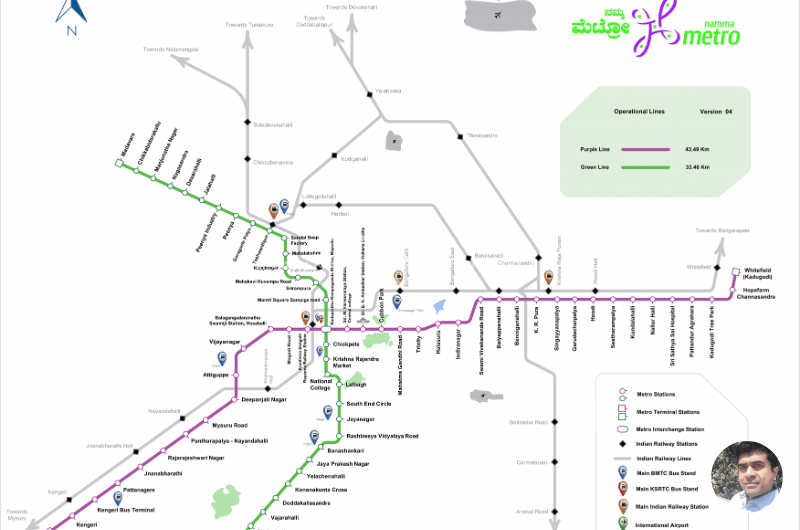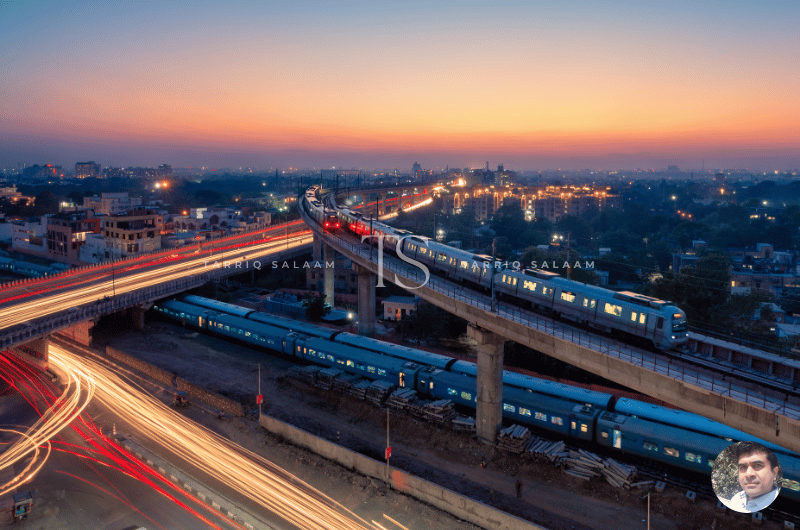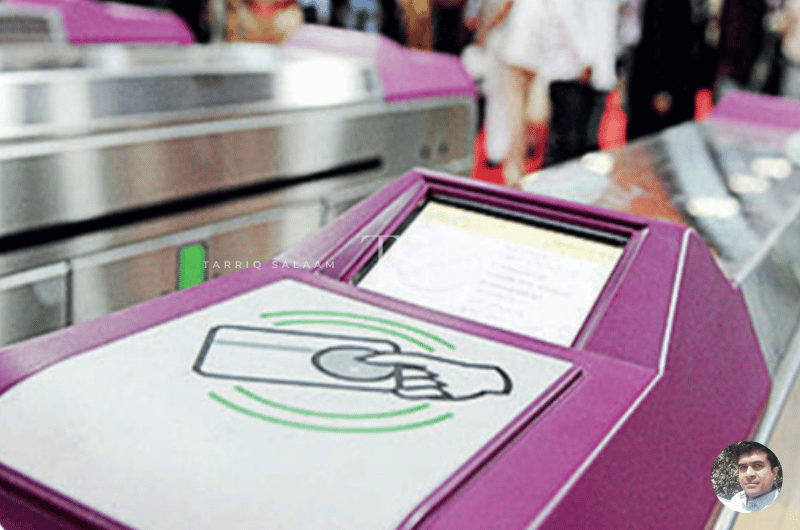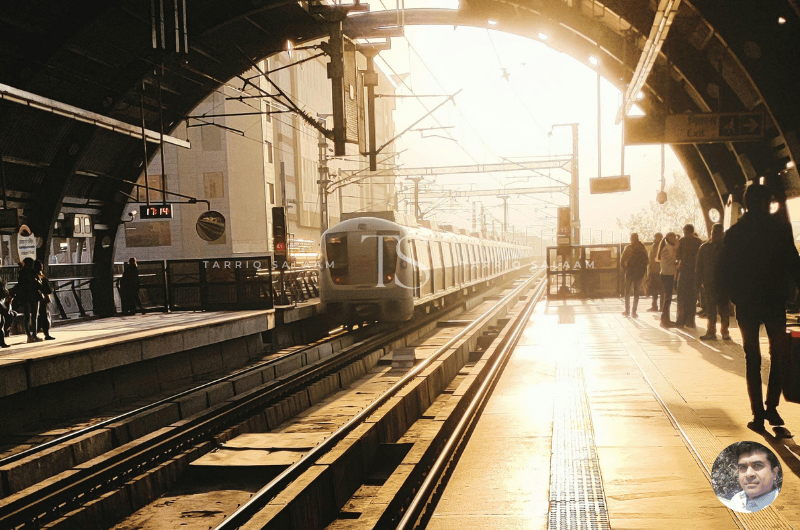I still chuckle when I remember my first ride on the Bangalore Metro.
I hopped on expecting a leisurely escape from Bengaluru’s legendary jams, only to find myself scrutinizing train schedules and fare charts like a traffic analyst.
But hey, compared to road chaos, Namma Metro really is a lifesaver… mostly.
From chaotic traffic to cool, air-conditioned coaches—Bangalore Metro didn’t just save my commute, it saved my sanity.
In this first-person tale, I’ll share the full scoop on Bangalore’s Metro system, routes, timings, fares, recent updates and even a dash of commuter chaos, all backed by the latest facts.
Consider it your one-stop blog guide to Namma Metro, with some humor and personal flair thrown in (I promise I won’t bore you with dry stats, though I will cite my sources for the serious stuff!).
Quick Information: Bangalore Metro
Too lazy to scroll through the whole article? I got you.
Here’s the cheat sheet — but hey, reading the full post might just save you from missing your metro stop in real life! 😉
| Quick Fact | Details |
| Began operation | 20 October 2011 (Phase-1 launch: Baiyyappanahalli–MG Road, Purple Line) |
| Owner/Operator | Bangalore Metro Rail Corp. Ltd. (BMRCL, Govt of India/Karnataka JV) |
| Locale | Bengaluru (Bangalore), Karnataka, India |
| Transit type | Rapid transit (metro rail) |
| Lines (operational) | Purple, Green, and Yellow |
| Stations | 85 stations (as of Aug 2025) |
| System length | 95.77 KM (operational, Aug 2025) |
| Operating hours | 05:00–23:00 daily (starts ~07:00 on Sundays) |
| Daily ridership | ~7.6 lakh (July 2024 average) |
| Top speed | 80 km/h |
| Fares (token) | ₹10–₹90 (minimum/maximum after 2025 hike) |
Quick notes
The Bangalore Metro network (called Namma Metro) has two fully operational lines (Purple and Green) as of 2025, with a 3rd (Yellow Line) set to open in August 2025.
There are 68 stations serving about 7–8 lakh riders on a normal weekday.
Trains run roughly from 5:00 AM to 11:00 PM (with service typically starting at 7:00 AM on Sundays), and come every 8–10 minutes (even as frequent as every 4 minutes during peak morning hours).
Fares range from ₹10 for very short hops up to ₹90 for the longest journeys.
The recent 2025 fare hike made Namma Metro ironically “the costliest metro in India” by per-kilometer rates.
Bangalore Metro Routes and the Network Map

(Source: BMRC)
👉 Click to download the Bangalore Metro Map PDF
If you look at the Bangalore Metro route map above (or click through to the official Metro Rail site), you’ll see how the lines snake through the city.
The Purple Line runs roughly east–southwest, currently connecting Whitefield (IT park in the east) through key hubs (KR Puram, MG Road, Majestic) down to Challaghatta/Kengeri in the southwest.
In fact, the Purple Line passes major centers like MG Road (Central Business District), Majestic (City Railway Station interchange), Vidhana Soudha (state secretariat), and Mysuru Road.
The Green Line spans north–south, from Madavara (north-west outskirts) to Silk Institute (south-west).
That Green corridor cuts through places like Peenya, Yeshwantpur (major industrial hubs), and Majestic (interchange again).
This means major stations/landmarks on the network include Majestic, MG Road, Whitefield (Kadugodi), Yeshwantpur, and so on.
Think of them as city-shaping points with easy transfer.
The Yellow Line (eastern periphery) has officially opened on the 10th of August, 2025.
It runs from RV Road (Rashtreeya Vidyalaya Road) down to Bommasandra, linking Electronic City to the network. (In fact, it’s fully elevated along the Outer Ring Road and Hosur Road.)
And beyond that, Bangalore has big Phase-2 & 3 plans: the Pink Line (Hebbal–JP Nagar) and Blue Line (to the Airport) are under construction, and an Orange Line (Magadi Road–Hebbal) is approved.
In short, all current and upcoming routes are plotted in the map above – operational (purple, green) and upcoming (yellow, pink, etc.).
This growing network aims to tie together tech corridors, malls, hospitals, and more, so you can avoid road snarls.
For a detailed official route map, the BMRCL website has a PDF, and Google Maps also shows metro lines – but the above graphic is a handy schematic.
You could also click here to download the Bangalore Metro Map PDF.
Bangalore Metro Stations
Want a list of stations across each current operating Bangalore Metro lines? I’ve got you covered! 🙂
Bangalore Metro Purple Line (37 Stations)
- Whitefield
- Channasandra
- Kadugodi Tree Park
- Pattandur Agrahara
- Sri Sathya Sai Hospital
- Nallur Halli
- Kundala Halli
- Seetharam Palya
- Hoodi Junction
- Garudachar Palya
- Singayyanapalya
- Krishna Raja Pura
- Benngiganahalli
- Baiyappanahalli
- Swami Vivekananda Road
- Indiranagar
- Halasuru
- Trinity
- Mahatma Gandhi Road
- Cubbon Park
- Dr. B. R. Ambedkar Stn., Vidhana Soudha
- Sir M Visveswaraya Station, Central College
- Nadaprabhu Kempegowda Station, Majestic
- Krantivira Sangolli Rayanna Railway Station
- Magadi Road
- Sri Balagangadharanatha Swamiji Stn., Hosahalli
- Vijayanagar
- Attiguppe
- Deepanjali Nagar
- Mysuru Road
- Pantharapalya – Nayandahall
- Rajarajeshwari Nagar
- Jnanabharathi
- Pattanagere
- Kengeri Bus Terminal
- Kengeri
- Challaghatta
Bangalore Metro Green Line (32 Stations)
- Madavara
- Chikkabidarakallu
- Manjunathanagar
- Nagasandra
- Dasarahalli
- Jalahalli
- Peenya Industry
- Peenya
- Goraguntepalya
- Yeshwantpur
- Sandal Soap Factory
- Mahalakshmi
- Rajajinagar
- Mahakavi Kuvempu road
- Srirampura
- Mantri Square Sampige Road
- Nadaprabhu Kempegowda Station, Majestic
- Chickpete
- Krishna Rajendra Market
- National College
- Lalbagh
- South End Circle
- Jayanagar
- Rashtreeya Vidyalaya Road
- Banashankari
- Jaya Prakash Nagar
- Yelachenahalli
- Konanakunte Cross
- Doddakallasandra
- Vajarahalli
- Thalaghattapura
- Silk Institute
Bangalore Metro Yellow Line (16 Stations)
- Rashtreeya Vidyalaya Road
- Ragigudda
- Jayadeva Hospital
- BTM Layout
- Central silk board
- Bommanahalli
- Hongasandra
- Kudlu Gate
- Singasandra
- Hosa Road
- Beratena Agrahara
- Electronic City
- Infosys Foundation Konappana Agrahara
- Huskur Road
- Biocon Hebbagodi
- Delta Electronics Bommasandra
Recent Expansions and Future Lines

The Bangalore Metro has been expanding in phases.
Here’s what’s new on the ground (or coming soon) as of 2025:
- Green Line North Extension: A long-delayed 3.14 km extension from Nagasandra up to Madavara finally opened on 7 November 2024. This added three stations (Manjunathanagar, Chikkabidarakallu, Madavara) and improved access to the exhibition centre (BIEC). Trains on this stretch started running every 10 minutes from 5:00 AM to 11:00 PM. (This stretch was dubbed “7-year delay” territory, but it’s now easing traffic on Tumkur Road.)
- Purple Line Extensions: By 2023, nearly the entire Purple Line was operational. Key recent additions include:
- 26 Mar 2023: Baiyyappanahalli–Whitefield (Kadugodi) section opened (13.7 km, though initially isolated pending a small link).
- 9 Oct 2023: The remaining gap Baiyyappanahalli–KR Puram opened, along with the Mysore Road–Challaghatta extension (2 new stations). These moves finally made the Purple Line continuous from Whitefield to Challaghatta.
- 30 Aug 2021: Earlier, the Mysore Road–Kengeri stretch (southwest reach) opened.
- Yellow Line: The 18.82 KM Yellow Line (RV Road–Bommasandra, 16 stations) is poised to open imminently. The government has slated its inauguration for 10 August 2025. (Prime Minister Modi himself is set to flag it off.) The Yellow line will finally plug Electronic City into the metro grid via RV Road, with interchanges at Jayadeva Hospital and Silk Board. BMRCL already has trains on standby, so it should be smooth sailing (fingers crossed) after the grand opening.
- Future projects (Phase 3 and beyond): Phase 3 (Orange/Pink Lines) is moving forward, though on a slower timeline. The so-called Pink Line (“Reach-6”) from Kalena Agrahara (JP Nagar 4th phase) north to Nagawara (Hebbal) – 21.26 km with 18 stations – is now expected by September 2026. This includes 7.5 km elevated (to Tavarekere) and 13.8 km underground (to Dairy Circle). In the longer term, Phase 3’s “ORR-west” Orange Line (to Hebbal) and others will take several more years to complete.
Key takeaway: The metro network is steadily growing. After recent openings (Green extension, Purple Inlays), you can look forward to Yellow Line rides soon. Major future lines (Pink/Hebbal) are on the way by 2026.
Bangalore Metro Fares, Tokens and Tickets

(Source: BMRC)
Now, onto the part that made me do a double-take – the fares.
On 9 February 2025, BMRCL instituted a major fare revision.
The upshot: Namma Metro became the costliest metro system in India by fare/km.
After the change, ticket prices run from Rs 10 minimum up to Rs 90 maximum (for journeys longer than 25 km).
To break it down, the distance-based fare table is roughly:
- Up to 2 km: ₹10
- 2–4 km: ₹20
- 4–6 km: ₹30
- …
- 15–20 km: ₹70
- 20–25 km: ₹80
- Above 25 km: ₹90
So yes, that once-cheap 2 km token still starts at ₹10, but a 30+ km ride (say, Whitefield to Madavara) now sets you back ₹90.
According to BMRCL, this bump was needed to help balance the books, but commuters have not been amused.
One local MP even tweeted that cutting service frequencies (causing “absolute chaos”) right after the hike was “unacceptable”!
In fact, ridership dipped after the hike, as some passengers grumbled they might ditch the metro for private cars.
Discounts & smart cards: There’s a bit of good news. If you use the Varshik smart card (prepaid contactless card), you get a 5% rebate on fares.
On top of that, BMRCL now offers off-peak discounts: an extra 5% off for traveling before 8 AM, midday, or after 9 PM on weekdays (making 10% total discount on smart cards), and a 10% bonus discount on weekends/holidays.
The Varshik card itself costs ₹50 (refundable) to purchase and you can load it online or at booths (min ₹50 recharge, max ₹3000 per load).
Group tickets (for 25+ people traveling together) also still exist with around a 10–15% off fare.
Tourist passes were also revised (₹300 for 1-day, ₹600 for 3-day, ₹800 for 5-day), which may be handy for visitors.
Payment modes: You can pay by single-ride tokens (coins only) or smart cards. In fact, the system supports tokens, QR e-tickets, and smart cards.
You can buy tokens at machines or booths (one journey, valid only for that trip) at any of the Bangalore Metro stations, or recharge your Varshik card at kiosks/ATVMs in English/Kannada/Hindi.
There’s even a (recently introduced) option to buy QR tickets via the Namma Metro app, Paytm, or WhatsApp – just scan at the gates.
I personally always carry a Varshik card, since it saves a bit on every ride.
In summary: expect fares between ₹10–90, with small discounts if you play the system (smartcards, off-peak). The new fare chart is official, and you’ll see the updated prices at stations.
Bangalore Metro Train Schedules and Timings

One of the first things I asked was, “When can I catch the first and last Metro trains?”
According to BMRCL’s official info, the Metro runs roughly from 05:00 to 23:00 every day (with service starting at 07:00 on Sundays).
In practice, trains begin rolling out of depots around 5 AM on weekdays, so early birds (and auto-drivers) take note.
The last trains generally run just before midnight.
On Sundays, you might see the first metro at 7 AM, but by Monday, it’s back to normal hours.
Frequency-wise, during peak hours (roughly 8 AM–8 PM), trains come about every 8 minutes.
There’s even a period (9–10 AM) when headways shrink to about 4 minutes for the real rush.
Outside rush hours, it relaxes to about every 10 minutes or so.
In short, Namma Metro’s schedule is decent: frequent service on working days, slightly reduced on weekends.
(The system can extend service to later hours for festivals or big events, but as a rule, expect around 11:00 PM as the end of service.)
Ticket counters and kiosks: When I first took the Metro, I marveled at the multilingual vending machines – you can choose English, Kannada, or Hindi on those touchscreen ATVMs.
They accept ₹5/₹10 coins or notes for tokens, and ₹50/100/500 notes (no ₹1/₹2 coins for recharge, FYI).
You can buy up to 8 tokens at once, or top up your smart card.
There are also staffed counters (human agents) at every station if you prefer paper tickets.
Rush Hour and Metro Chaos
Commuting by metro is mostly peaceful… but occasionally things get wild.
For example, one Monday morning in April 2025, the frequency was unexpectedly cut to 10-minute gaps (presumably a false alarm holiday), and packed platforms erupted in chaos.
Videos of shoulder-to-shoulder crowds at Majestic and Magadi Road stations flooded social media.
Even Bangalore’s Central MP complained of “absolute chaos” as already-full trains arrived back-to-back.
Commuters lamented that after the fare hike, they deserved better service – no one likes standing on a platform for half an hour in the morning, let alone paying ₹90 for it!
Ultimately, BMRCL scrambled extra trains to cope, but that incident shows what happens when a smooth schedule hits a snag.
On a lighter note, I once joked to a friend that taking the Metro during rush feels like a bonus cardio workout.
You might line up at Majestic, wondering if it’s an induction for future marathon runners!
Thankfully, such extreme crowding is rare and often fixed quickly.
The usual scene is orderly boarding and security checks.
(And pro tip: on busy days, jump in quickly or get a seat on the down escalator at Majestic – that “up escalator crowd” can look like a festival queue.)
The Bangalore Metro does get teething problems occasionally – delays, technical snags, or maintenance.
But overall, it’s a vast improvement over crawling behind a tank-like BMTC bus in traffic.
In any case, I’ve found it pays to check the Metro Twitter/X account or BMRCL press notes for any disruptions before you head out.
Stations and Key Interchanges

With 68 stations (59 elevated, 8 underground, 1 at-grade as of Nov ’24), Bangalore Metro serves a wide range of neighborhoods.
Major interchange stations are:
Majestic (Kempegowda Station) – where you can hop between Purple & Green lines;
RV Road (first Yellow-Line interchange on Green);
Silk Board – where Yellow crosses future Blue;
Jayadeva Hospital – where Yellow meets Pink.
Other big stops include MG Road, Yeshwantpur, Kalena Agrahara, Krantivira Sangolli Rayanna (City Railway Station), and Kadugodi.
For a full station list, the BMRCL website has a page (and each station is labeled on maps).
But from personal experience: checking the station announcements and displays is a must!
Since trains can be busy, I always listen for the automated English/Kannada announcement: “Next station – Trinity Station” or “Majestic interchange – change platforms”.
The trains also flash an LED list of stops, which is helpful.
Major upcoming stations to remember: on the Green Line, Madavara (new terminal); on Purple, Challaghatta (new terminal); on Yellow, RV Road (RV Road station opened on the existing Green line in 2016 to facilitate this future line).
When Yellow opens, keep an eye out for Electronic City on the line – it’ll be the first time our Metro reaches the southern tech hubs.
Frequently Asked Questions
What are the Metro operating hours and frequency?
Namma Metro trains generally run from 5:00 AM to 11:00 PM on weekdays (about 7:00 AM start on Sundays). During peak hours (roughly 8 AM–8 PM), expect a train every 8 minutes or so; in fact, there’s about a 4-minute gap in the morning rush hour. Evenings and off-peak run around every 10 minutes. Frequency occasionally dips on certain holidays or events, so always check BMRCL updates if you’re planning an early/late trip.
How many lines and stations are there?
Currently, there are 2 operational lines – Purple and Green – with a 3rd (Yellow) nearly ready. The system has 68 stations as of late 2024. Purple Line has 37 stations (Whitefield ↔ Challaghatta, 43.45 km), Green Line has 30 stations (Madavara ↔ Silk Institute, 33.46 km). Yellow Line (RV Road ↔ Bommasandra, 16 stations) is due to open Aug 2025. Key interchanges include Majestic, RV Road, Jayadeva Hospital, and Silk Board.
What are the ticket fares now?
After the Feb 2025 revision, fares start at Rs 10 (shortest journey) and go up to Rs 90 (longest journey). For example, ~2 km costs ₹10, ~10 km costs ₹60, >25 km costs ₹90. Varshik smart-card users get a 5% discount (with an extra 5–10% off during off-peak hours or on weekends). In short, think ₹10–90, with small discounts for smart card/off-peak travel.
How do I buy tickets or smart cards?
You can use the Ticket Vending Machines or counters at stations. The system accepts contactless tokens (one-trip tickets), QR e-tickets (via app/WhatsApp/Paytm), or the Varshik smart card. To use a smart card, buy one (₹50 deposit) and load it with ₹50+ at the kiosks. Tokens are purchased by selecting the destination or fare on the machine. Smart cards give quicker boarding (tap-and-go) and 5% off fares. Groups of 25+ can buy special group tickets with further discounts.
Is there a route map available?
Yes, BMRCL publishes an official network map on its website (also displayed at stations). You can find the downloadable PDF map there, or simply look up “Namma Metro route map” online for schemes. The map above in this post is a good schematic. It shows current lines (purple, green) and upcoming ones (yellow, etc.) for orientation. (For navigation, Google Maps also has the lines marked on it now.)
What about the Green Line extension?
It’s open! The Green Line was extended 3.14 km from Nagasandra to Madavara on 7 November 2024. There are now three new stations (Manjunathanagar, Chikkabidarakallu, Madavara). Trains run this stretch every 10 minutes from ~5:00 AM to 11:00 PM, integrating it into regular service.
When will the Yellow Line start?
BMRCL has scheduled the Yellow Line (Rashtreeya Vidyalaya Road ↔ Bommasandra) to begin operations on 10 Aug 2025. The line was cleared for safety on Aug 1, 2025, and trains are ready at the depot. So if all goes well, you should be riding it in August 2025.
My Final Thoughts
Riding the Bangalore Metro has definitely saved me countless hours stuck in traffic, and I try to enjoy it even when I’m jostled in the train or surprised by a sudden delay.
Overall, though, Namma Metro is a huge upgrade for Bangalore’s commuters.
It’s expanding fast (just look at those new lines and extensions!), offers a reliable alternative to buses/cabs, and even gave me material for a funny blog post.
That said, be prepared for the quirks: carry a smartcard for discounts, allow a minute or two extra for the occasional crowd-crush, and don’t be shy about standing when trains fill up.
The Metro police and staff are generally helpful, and announcements in Kannada and English keep you from missing stops.
So until we swap bumper stickers for rail tickets, I’m signing off – next stop, hopefully snacks and WiFi on the train.
Happy commuting, and see you on the Metro!
Found the article informative? Was it helpful?
Let me know in the comments below. I’d love to hear from you. 🙂
Follow me for more insider guides, lesser-known facts, and unforgettable experiences across Bangalore and beyond.
Until next time,
Exploring Bangalore, one story at a time — right here on tariqsp.com.




